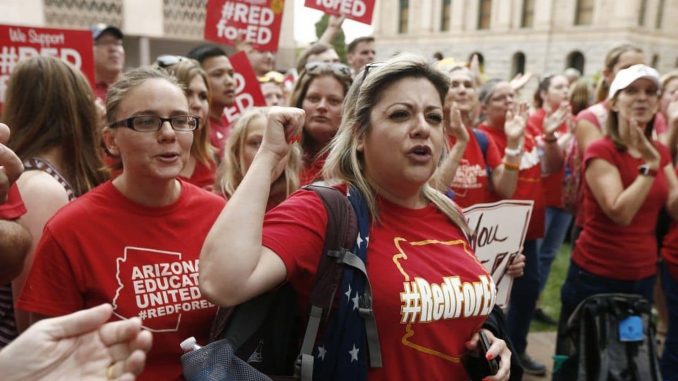
The successful West Virginia Teachers Strike in March has inspired walkouts and demonstrations by school teachers and staff in other states, and strikes in Oklahoma and Arizona. Education workers are demanding increased funding for school programs their students need as well as pay raises.
Oklahoma
The Oklahoma government has cut the education budget by 16% over the last 10 years. The cuts mean that in-state funding per student has declined 28% since 2008. The cuts were largely driven by a 25% income tax cut that mostly benefitted the wealthiest 6% of Oklahoma’s citizens, as well as its oil and natural gas industry.
These cuts resulted in four-day school weeks in 20% of the state’s school districts, where many textbooks are so old they are held together by duct tape. Since 2008 the average number of students in each classroom has increased by 43%. Oklahoma ranks 49th in the country for teachers’ salaries, without a raise in 10 years. No wonder 18% of Oklahoma teachers have quit to work in other states.
Oklahoma teachers demanded an increase in education spending by $1.1 billion per year for the next three years, including a $10,000 raise for teachers. In response, the governor proposed only a $6,000 raise. This would come from a small increase in taxes on fossil fuels, and an increase in cigarette taxes. Both the governor and the legislature refused to increase the budget for resources and staff in schools. They refused any measure that would mean reversing the huge tax breaks for the wealthy.
On Monday, April 3, more than 30,000 Oklahoma education workers walked off the job. Thousands of teachers rallied at the state capitol for two weeks. By the end of the demonstrations, the leading teachers’ union officials – some of whom had opposed the strike from the start – issued a call to end the strike and accept the governor’s offer. Many rank and file teachers disagreed, but on Monday April 17 most of the striking teachers returned to work.
The kind of grass roots organization of teachers that existed in other states wasn’t as developed in Oklahoma. Many Oklahoma school districts saw few or even no meetings of classroom teachers to set goals, build teams of strike leaders, and vote on the issues of the strike. The absence of these structures made it hard to maintain morale and unity, and ultimately enabled the union officials to call an end to the strike.
In contrast, West Virginia classroom teachers built grass roots organization over several months with tactics which included coordinated strike votes in every school district, along with preparatory demonstrations showing parent and community support. As a result, every West Virginia school district shut down for the duration of the two-week strike. This gave the strikers a huge morale boost and intimidated the politicians. West Virginia Union leaders tried to get the teachers to return to work in exchange for empty promises from the state’s governor, but the grassroots network counteracted this decision.
Arizona
Arizona’s government has cut the education budget by 36% over the last decade, giving tax cuts to the wealthy and corporations. Starting in March, Arizona teachers began demonstrating and petitioning, demanding the state government raise salaries and reverse the cuts to education.
The governor offered to raise Arizona teachers’ salaries by 9% but said that this increase would be bankrolled with cuts to educational programs such as special needs classes. On April 26, more than 50,000 teachers and education support staff walked out.
On the first day, the strike shut down over 1,000 public schools. Many families joined striking teachers in rallies around the state. More than 70,000 strikers and supporters marched on the state capitol in Phoenix despite the 95-degree heat. The strike remained solid into its second week, and efforts by school districts to re-open closed schools fizzled out.
Two days into the strike, the Arizona government promised to raise teachers’ pay 20% over two years along with some increases in funds for school programs. Some teachers thought now they could end the strike, but a majority of teachers made it clear they weren’t going back to work until the state legislature and the governor signed the promised increases into law, which they did on May 3.
These strikes show that many rank-and-file teachers and staff have begun to fight back, not just for pay, but to defend young peoples’ education. Most teachers’ union officials aim to channel this energy into the Democratic Party’s 2018 election campaigns. But the Democrats have also frequently passed budgets cutting education. For example, in Democrat-dominated California, money for schools is 11% lower than it was in 2008.
Only a real movement and strikes can force concessions from the government. The spread of public school teachers and staff struggles are a signal that all workers can organize to turn things around.

